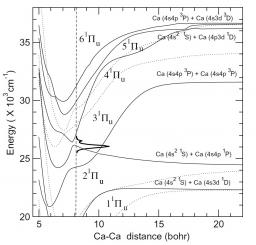
Ab initio potential curves of 1Πu symmetry correlating to the asymptotes labeled in the figure. The four lowest energy 1Σu states are indicated by dotted lines. The zero energy is taken at the bottom of the ground state well of Ca2. The vertical dashed line shows the calculated equilibrium distance of the ground state. The theoretical absorption spectrum is represented in thick solid lines, with the zero intensity corresponding to the above mentioned dashed line.
We report experimental and theoretical evidence of a non-Rydberg molecular doubly excited state of Ca2 involving excited molecular orbitals mixing 4p and 3d characters. The excitation spectrum of Ca2, carried by helium or argon clusters, is recorded experimentally in the range 25600–27800 cm-1, displaying a bimodal structure. The latter is interpreted from ab initio calculation and analysis of the adiabatic states of Ca2 up to doubly excited asymptotes Ca(4p3d 1D) + Ca(4s2 1S) and Ca(4s3d 3D) + Ca(4s4p 3P), and the relevant dipole transition moments. The bimodal structure is assigned as resulting from the avoided crossing between adiabatic states 31Πu and 41Πu, reflecting the mixing of doubly excited configurations and absorbing singly excited configurations.












